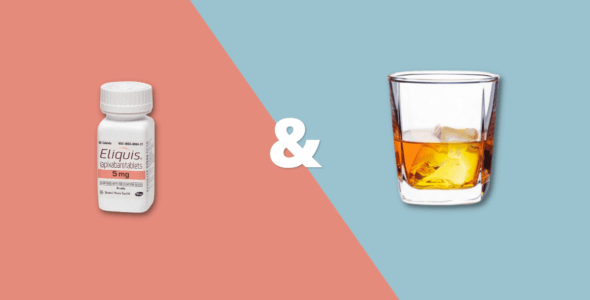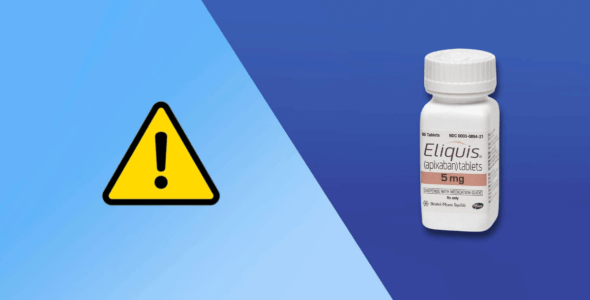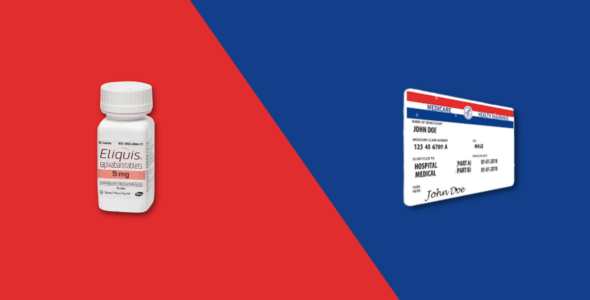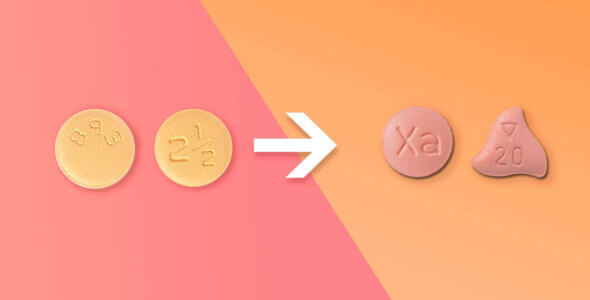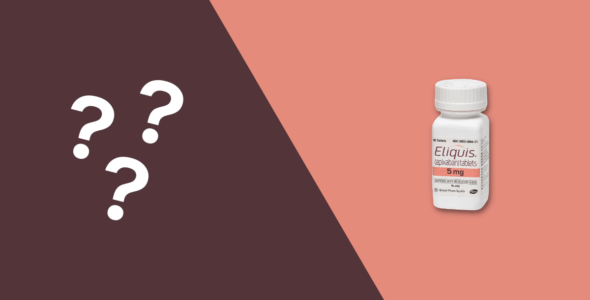Pradaxa and Eliquis are FDA-approved medications known as direct oral anticoagulants (DOACs), non-vitamin K antagonist oral anticoagulants (NOACS), or blood-thinning drugs. Clinical trials have shown these drugs are faster acting than vitamin K antagonists like warfarin (Coumadin), are more predictable, meaning you may not need to have blood tests, and have a lower risk of bleeding side effects.
2019 guidelines from the American College of Cardiology, the American Heart Association, and the Heart Rhythm Society recommend DOACs as a treatment option for atrial fibrillation patients and stroke prevention. Other available medications in this category include rivaroxaban (Xarelto) and edoxaban (Savaysa), but here we will focus on the similarities and differences between Pradaxa and Eliquis. Read on to learn more.
What is Pradaxa?
Pradaxa is a blood thinner medication prescribed to adults to lower the chance of blood clots forming. Specifically, it is used to:
- Lower the risk of stroke (systemic embolism) and blood clots in people who have a medical condition called atrial fibrillation (Afib)
- To treat and prevent blood clots forming in veins in the legs (deep vein thrombosis) or lungs (pulmonary embolism)
- To help lower the risk of blood clots forming in veins in the legs (deep vein thrombosis) or lungs (pulmonary embolism) of people who’ve had hip replacement surgery
Pradaxa can be taken to treat existing blood clots and to reduce the chances of blood clots forming. It works by interrupting a step in the blood clotting process. Pradaxa is not for use in people with artificial heart valves.
How does Pradaxa work?
The active ingredient in Pradaxa is called dabigatran etexilate mesylate, usually just called dabigatran. Blood normally clots through a complex chemical reaction with multiple steps. Some of the steps of this reaction use enzymes to help change your blood from a liquid to a gel. One of these enzymes is called thrombin. Dabigatran works by blocking thrombin. When you swallow Pradaxa, molecules of dabigatran are absorbed in your blood, where they bind to thrombin preventing it from working.
How do you take Pradaxa?
Pradaxa is available in capsule form, in the following doses: 75mg, 110mg, and 150mg.
Take Pradaxa capsules orally exactly as prescribed by your healthcare provider.
What is Eliquis?
Eliquis is an anticoagulant, a type of drug that stops blood clotting (turning from a liquid to a thick gel). Eliquis is used to prevent blood clots from forming in people who have:
- Nonvalvular atrial fibrillation (heart arrhythmia not caused by a heart valve problem) and who have other clotting risk factors
- Had hip or knee replacement surgery
It’s also used to treat blood clots in the legs (deep vein thrombosis) and lungs (pulmonary embolism), and to stop blood clots from reoccurring in these places.
How does Eliquis work?
The active ingredient in Eliquis is an anticoagulant called apixaban. As blood clots, it goes through a process of chemical reactions that turns it from a liquid into a thick gel. An enzyme called factor Xa is an important part of this process. Eliquis targets this enzyme. The active ingredient apixaban attaches to factor Xa to stop it from working, reducing the likelihood of blood clots forming.
How do you take Eliquis?
Eliquis is available in tablet form, in the following doses: 2.5 mg and 5 mg.
The recommended dose of Eliquis is 5 mg orally twice daily. Always speak with a healthcare professional about any changes to your dose so they can monitor and evaluate your condition.
Pradaxa and Eliquis and bleeding
Your blood forms clots to plug cuts and injuries, stopping you from bleeding. Because Pradaxa and Eliquis reduce blood clots, they can both put you at a higher risk of bleeding. The bleeding can be serious, even fatal. You may also bruise more easily.
You should avoid other medications that increase your chances of bleeding. These include aspirin and other antiplatelet agents, as well as other anticoagulants, selective serotonin reuptake inhibitors (SSRIs), serotonin-norepinephrine reuptake inhibitors (SNRIs), and nonsteroidal anti-inflammatory drugs (NSAIDs) like ibuprofen.
The increased risk of bleeding may on occasion turn into a risk of major bleeding, causing life-threatening issues. Inform your doctor if you are taking Pradaxa or Eliquis before you have any medical or dental procedures or surgery. If you are taking Pradaxa or Eliquis and you begin to bleed, or you experience symptoms of blood loss, seek urgent medical attention.
Common side effects of Pradaxa and Eliquis
The most common side effects are related to bleeding for both Pradaxa and Eliquis, these include:
- Nosebleeds
- Bleeding gums
- Heavier menstrual bleeding
- Unexpected vaginal bleeding
- Bruising
Pradaxa side effects
- Nausea
- Abdominal or stomach pain
- Indigestion
- Heartburn
- Diarrhea
Eliquis side effects
- Swelling or joint pain
- Headache
- Rash
- Chest pain or tightness
- Dizziness
Pradaxa may cause more gastrointestinal side effects than Eliquis.
This is not a comprehensive list of all the side effects Pradaxa and Eliquis can cause. Side effects will depend on the dose you are taking and the condition you are being treated for. You can find more details on side effects in the patient leaflet that comes with your medication. If you have any concerns about Pradaxa or Eliquis side effects, talk to your physician or a pharmacist. You are encouraged to report negative side effects of prescription drugs to the FDA. Visit www.fda.gov/medwatch or call 1‑800‑FDA‑1088.
Make sure you tell your prescribing physician about all medications you’re taking, including supplements and over-the-counter meds to prevent any drug interactions. You should also inform your healthcare provider of all medical conditions you may have. In particular, asthma, diabetes, heart disease, hypertension, and any kidney problems.
